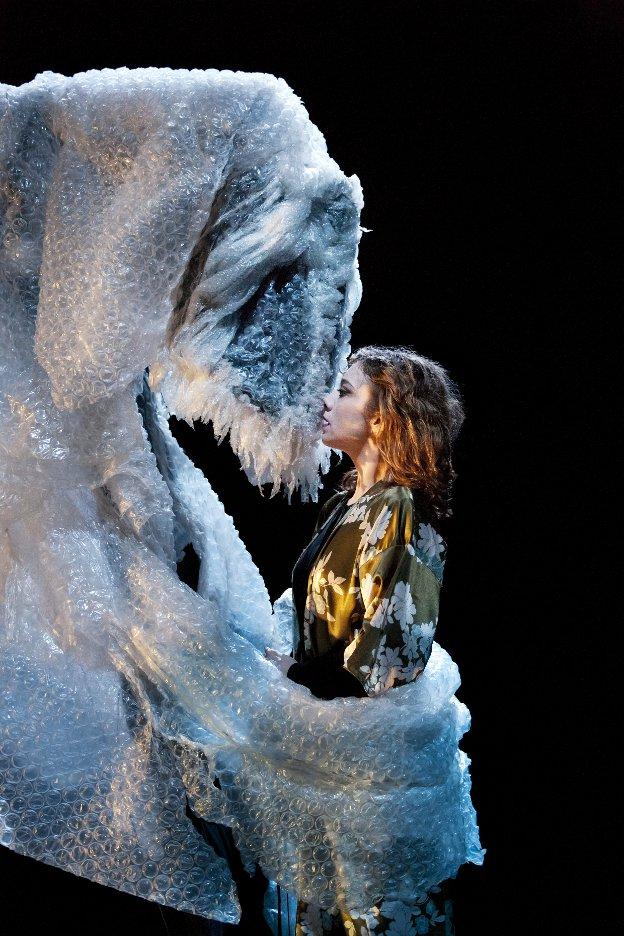Ah, the walls, the walls – our lives are bound by them! Literal walls, metaphorical walls… But what if life is but a dream? Or what if we acknowledge (in the words of Jacques Lecoq, with a nod towards the Buddha) that ‘tout bouge’ – everything moves, nothing is solid? Where does that leave these repressive boundaries? Gone in a puff of smoke, that’s where.
In Murmurs, we are presented with a world made not of bricks and mortar but of cardboard packing boxes and crumpled curtain fabric. There is much play on absence and presence; on dressing and undressing; on covering and revealing; on solidity and mutation. Here today and gone tomorrow is the message; magic is the medium.
The opening scene places Aurélia as an ethereal creature surrounded by a set of boxes, a pair of removal men attempting a house clearance aided and abetted by our heroine, who we might take to be an awkward lodger or a ghost who won’t move on. The scenes that follow manage to be both fast-moving and other-worldly, perhaps mimicking the way dreams play out. Nothing is quite seen through – as soon as it arrives, it departs.
Illusion is the name of the game: lightweight buildings swoosh across the stage, then roll up into nothing; a pair of red shoes magically reappears onto a pair of pretty feet again and again, despite the fact that we clearly see them packed away; and a shapely leg crossing a threshold remains in place as its owner materialises elsewhere. Aurélia’s elusiveness is key to the piece. Popping up out of boxes, through windows, or from behind screens – never where you expect her to be, always one step ahead of the game – she is the desirable ‘other’ that is chased, flirted with, and occasionally captured momentarily by her two male foils (played by Jaime Martinez and Magnus Jacobsson) and by the various puppet-creatures, formed from everyday objects such as bubblewrap or bellows, that arrive in this other-world. It’s all breathlessly beautiful, and constantly unnerving.
Murmurs is the second show by Aurélia Thierrée to be created with / directed and designed by her mother Victoria Thierrée Chaplin, and comes with a lot to live up to. The first show by this team, Aurelia’s Oratorio, took the world by storm eight years ago and is seen as one of the defining moments in contemporary visual theatre. Then, there’s Victoria Thierrée’s thirty-year body of work with her husband Jean-Baptiste Thierrée, on Le Cirque Imaginaire andLe Cirque Invisible, which is often credited as giving birth to New Circus, looming over. (Aurélia made her stage debut with her parents, performing as a suitcase with legs – the image of legs appearing out of or behind objects is a continuing motif in her work!) Victoria has also collaborated with Aurélia’s brother James Thierrée on his renowned Junebug Symphony and La Veillée des Abysses. How could Murmurs possibly live up to the expectations seeded by this track record?
It doesn’t is the short answer – but that has to be qualified by saying that even a ‘less interesting’ piece by the Thierrée-Chaplins is worth seeing. Whilst watching the piece, I found myself frustrated by the constant fluctuations and wanted more things to be ‘seen through’. On reflection, after the show, I realise that this fluctuation is dramaturgically key to the notion of dissolving walls at the heart of the piece. I also, at the time, found the lighting to be rather odd – lots of steely-blues and straw-white washes rather than strongly focused spots, so the eye often had to make its own decision where to look. But perhaps the right effect for a dream world?
There’s an interesting moment at the curtain call: as Aurélia skips across the stage and takes the hands of Jakobsson and Martinez, there’s a kind of complicity and joyousness danced out that I suddenly realised was sorely missing from the show itself. Perhaps a little less ‘magic’ and a little more magic is needed.
It should, though, be acknowledged that both Aurélia’s Oratorio and Le Cirque Invisible were years in the making and have been constantly honed whilst touring. Murmurs is a recently-devised work, and was seen on the opening night of its London run. It’ll be interesting to see how it develops over time.


